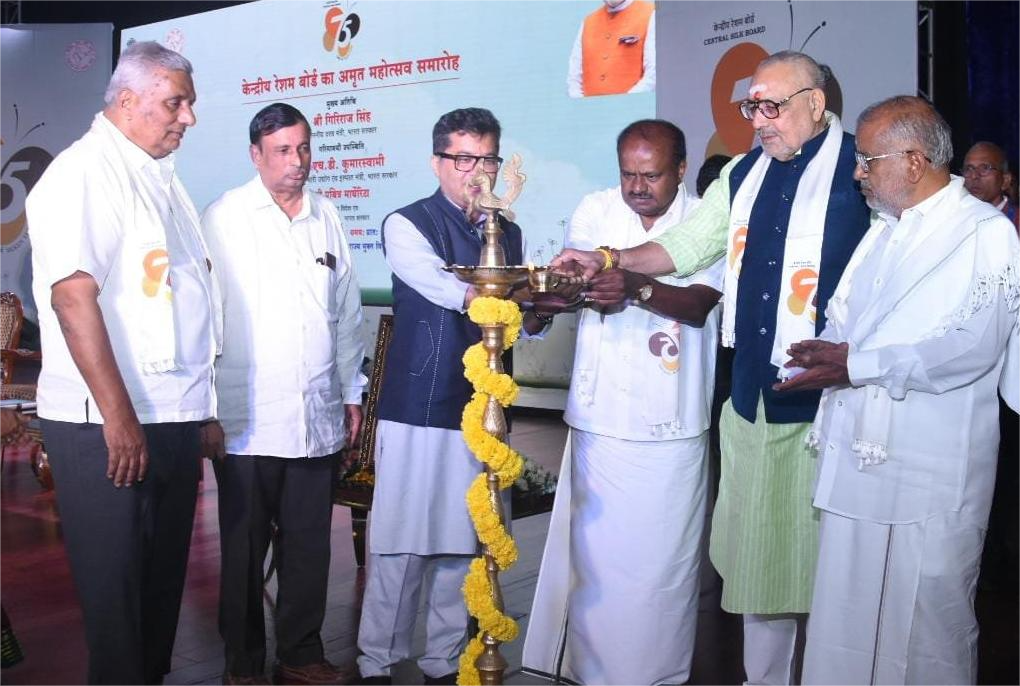Giriraj Singh Unveils Commemorative Coin Celebrating 75 Years of Central Silk Board
One of the most significant highlights of the event was the introduction of Silk Mark India (SMOI), an official website aimed at ensuring silk quality through certification.

- Country:
- India
On September 20, 2024, Union Minister of Textiles Shri Giriraj Singh unveiled a commemorative coin at the Platinum Jubilee celebrations of the Central Silk Board (CSB) in Mysuru, marking 75 years of CSB's pivotal role in transforming India's silk industry. The event also witnessed the release of new technologies, mulberry varieties, and collaborations aimed at boosting the sector.
The Central Silk Board (CSB), established in 1949, marked its 75th anniversary with a grand celebration on September 20, 2024, in Mysuru. The event was graced by Union Minister of Textiles Shri Giriraj Singh, who unveiled a commemorative coin to honor the institution’s decades of service to India’s silk industry. Joining him were key dignitaries, including Union Minister of Heavy Industries and Steel Shri H.D. Kumaraswamy, Minister of State for External Affairs and Textiles Shri Pabitra Margherita, and Minister of Animal Husbandry and Sericulture from Karnataka Shri K. Venkatesh, among others.
As part of the Platinum Jubilee celebrations, a documentary showcasing CSB’s rich 75-year journey was released alongside a Coffee Table Book titled CSB in the Service of the Nation Since 1949 and a commemorative postal cover featuring the CSB 75 Years Logo. These releases highlighted CSB’s relentless dedication to revolutionizing India's silk industry and propelling it onto the global stage.
New mulberry varieties and silkworm hybrids, such as CBC-01 (C-2038) for Eastern and Northeastern India and CMB-01 (S8 x CSR16) and CMB-02 (TT21 x TT56), were introduced to increase silk production, especially in diverse and underserved regions. Additionally, four innovative technologies—Nirmool, Seri-win, Mr. Pro, and a new trapping machine—were launched, promising to improve pest management and boost sustainability in sericulture.
One of the most significant highlights of the event was the introduction of Silk Mark India (SMOI), an official website aimed at ensuring silk quality through certification. This development, along with the release of 13 books, 3 manuals, and a Hindi magazine focused on sericulture, provided crucial educational resources for farmers and stakeholders.
The event also witnessed the signing of Memoranda of Understanding (MoUs) between the CSB and renowned institutions like ICAR-CIFRI Barrackpore, Jain University Bengaluru, and Assam Agricultural University (AAU) Jorhat, marking a step forward in sericulture research and development. These collaborations are designed to strengthen cooperative efforts and enable groundbreaking research that supports both innovation and training in the silk sector.
A Rich Legacy of Sericulture Development
The Central Silk Board’s establishment dates back to 1949 when it was formed under an Act of Parliament to shape India's sericulture industry. Over the past 75 years, the CSB has been the central force behind the growth and expansion of India’s silk sector, playing a leadership role in research and development, silkworm seed production, and standardization of processes.
Today, the CSB operates across 159 units in 26 states and Union Territories, conducting research, developing over 51 region-specific silkworm hybrids, and cultivating 20 high-yielding host plant varieties. Notably, CSB’s R&D efforts have led to the production of Indigenous Automatic Reeling Machines, reducing India’s dependence on Chinese imports.
Through decades of innovation, the Central Silk Board has facilitated India’s rise as a global leader in silk production. From producing 1,242 metric tonnes of raw silk in 1949, India now produces 38,913 metric tonnes in 2023-24. The country’s share in global silk production has surged from a mere 6% in 1949 to 42% today. Productivity has also improved dramatically, with raw silk production efficiency (renditta) dropping from 17 to 6.47, and output per hectare of mulberry plantations rising from 15 kg to 110 kg.
The CSB has also driven remarkable growth in silk exports, with earnings increasing from ₹0.41 crores in 1949-50 to an impressive ₹2,028 crores in 2023-24, with exports reaching over 80 countries worldwide.
Building a Sustainable Future for Sericulture
As part of the two-day celebrations, stakeholders from the silk industry gathered for a Seri-stakeholders Experience-sharing Session. This platform allowed participants, including farmers, policymakers, and industry experts, to exchange ideas and discuss the future of the silk sector. Key suggestions included developing platforms to use sericulture waste in animal feed and pharmaceuticals, improving market facilities, stabilizing cocoon prices, and reducing the role of middlemen to increase profits for farmers.
Participants also advocated for subsidies on essential sericulture components and called for adjustments to unit costs in line with market inflation. These discussions aim to further strengthen the silk industry by ensuring fair prices and market stability for all stakeholders, particularly the farmers who form the backbone of this thriving sector.
As the CSB enters its next phase, its commitment to innovation, sustainability, and global competitiveness will continue to propel India’s silk industry forward, positioning the nation as a dominant force in global silk production and trade.
- READ MORE ON:
- Central Silk Board
- Giriraj Singh









